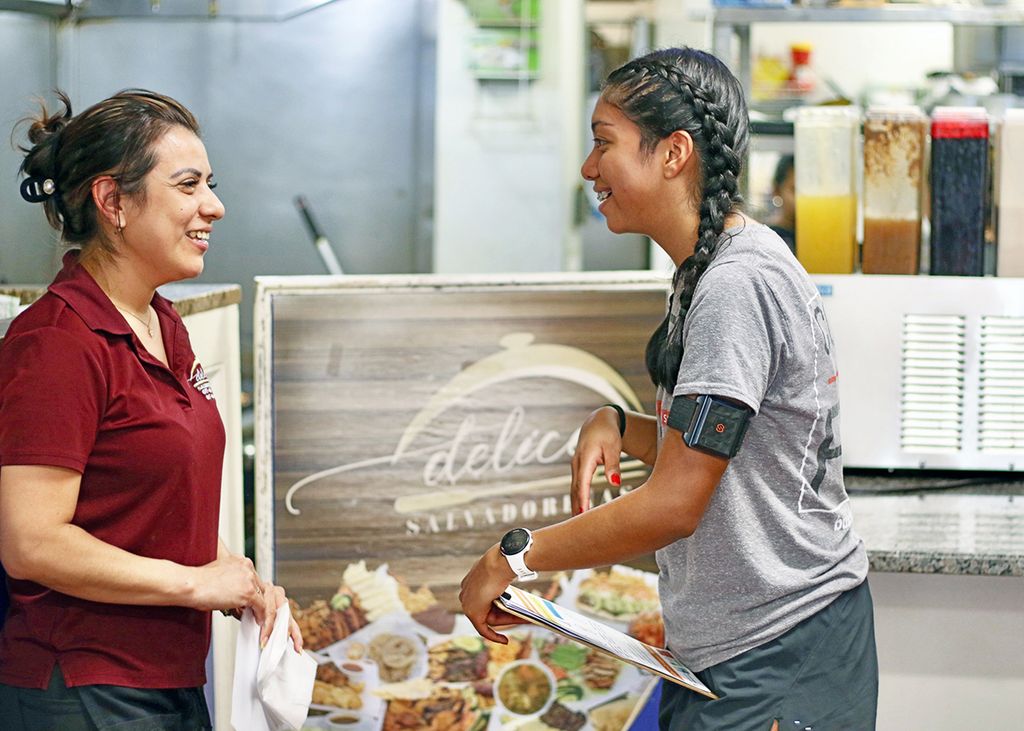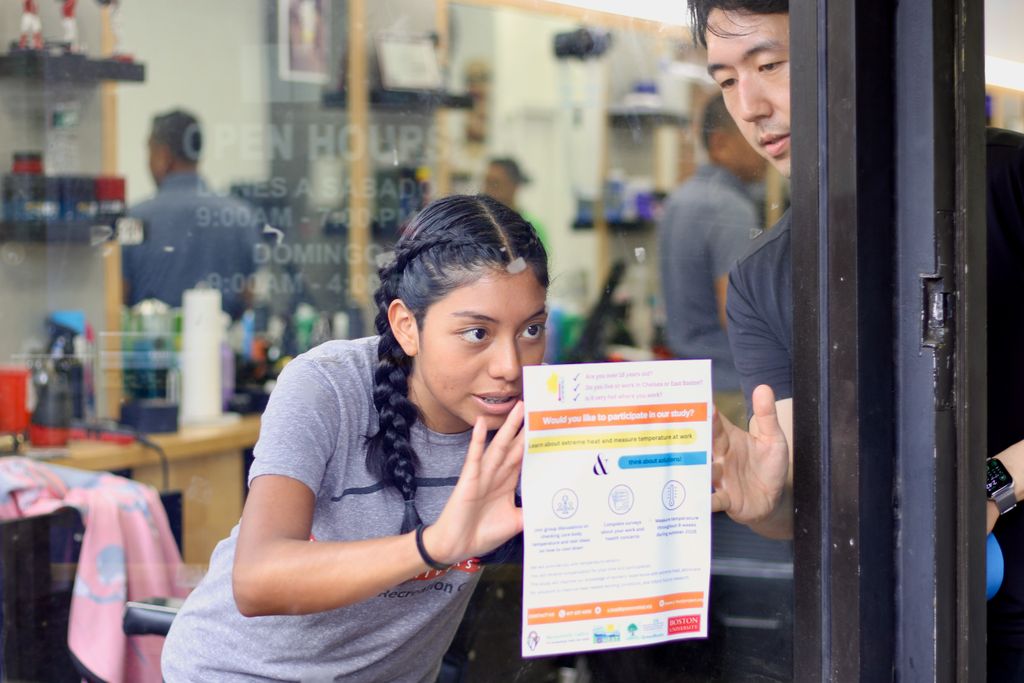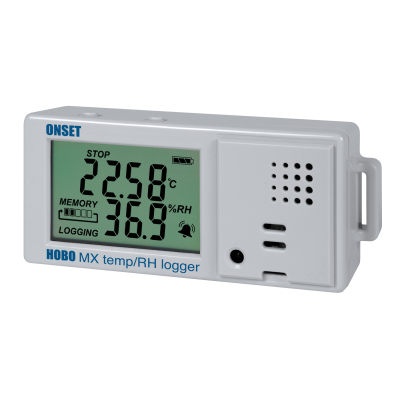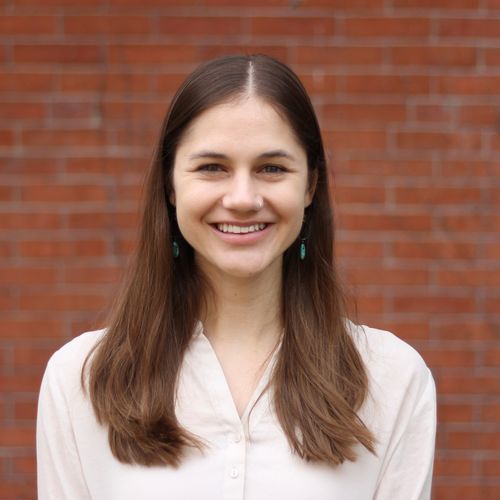Sweating for Science: SPH Measures Heat Where Bostonians Work, Play, and Live.

Jonathan Lee (left), a PhD student in the Department of Environmental Health, and Yirong Yuan (CAS’24), a research data analyst in the department, set up two temperature sensors, one in the shade and one in the sun, on a hot day at the Franklin Park Zoo. PHOTO: MEGAN JONES
Sweating for Science: SPH Measures Heat Where Bostonians Work, Play, and Live
As the summer heat intensifies in Boston, teams of SPH researchers have deployed a variety of sensors across the city to assess heat exposure among vulnerable residents and evaluate cooling interventions.
Heat in the Workplace
On a steamy June day in Chelsea, Massachusetts, three students—Victoria A. Lopez, a Master of Public Health student, and PhD candidates Charlotte Robbins and Jonathan Lee from the Department of Environmental Health—step into a bakery to recruit participants for a workplace heat study.
Lopez introduces the project, a collaboration between the School of Public Health, GreenRoots, and Massachusetts Coalition for Occupational Safety and Health (MassCOSH), which aims to enroll up to ten people who work in hot environments to better understand their experience of heat and identify effective ways to stay cool on the job.
Robbins explains that participants will wear sensors over an approximately nine-week period starting in July to monitor core body temperature, heart rate variability, and ambient temperature. They will also complete daily reflections and take part in interviews about the effects of heat on their health and comfort. Lee, the project leader, hands the bakery employees a flyer with the study details and the team’s contact information, and the group continues down the street to share the study with other local businesses.

Victoria A. Lopez (right), an MPH student, discusses participation in the occupational heat exposure study with an employee of a restaurant in Chelsea. There is a SlateSafety Band V2 sensor strapped around Lopez’s upper left arm. PHOTO: MEGAN JONES
The students’ canvassing efforts are part of a new pilot project launching this summer under the umbrella of the Chelsea & East Boston Heat (C-HEAT) study, a research partnership between SPH and GreenRoots launched in 2020 to investigate and address the health effects of extreme heat in the two communities. Using non-invasive, wearable sensors—the Band V2 from SlateSafety—this summer’s pilot aims to monitor heat stress among vulnerable workers and identify effective cooling strategies.
According to Madeleine Scammell, a professor in the EH department and a co-principal investigator on the C-HEAT study, the objective of the pilot is to test this methodology for the submission of a future grant proposal to scale this study to include a larger number of urban workers across Massachusetts over a longer timeline. “During the summer of 2021, twelve residents of the Chelsea and East Boston participated in a Photovoice project that identified small business workers as being at elevated risk of dangerous heat exposure,” says Scammell. “We hope that the data we collect this summer will advance advocacy efforts and protective measures to improve heat-related working conditions.”

Lopez (left) and Lee (right) post a sign in the window of a barber shop in Chelsea to recruit participants to a new pilot study of occupational heat exposure. PHOTO: MEGAN JONES
The BU Initiative on Cities awarded Lee, Scammell, and Patricia Fabian, an associate professor in the EH department and co-principal investigator on the C-HEAT study, a 2025 Early Stage Urban Research Award to purchase the sensors for the project, which is formally titled “Occupational Heat & Cooling Strategies: A Pilot Study.” The research, like many other C-HEAT projects, is also funded by Boston’s Barr Foundation.
Heat on the Playground
Meanwhile, across the Chelsea Creek, Beverly Ge, another EH PhD student, climbs a ladder to secure a small white box to a tree branch. The box contains another type of heat sensor— the HOBO Temperature/Relative Humidity Data Logger from Onset. The tree is in the playground of an early childhood education center participating in another study of heat exposure and cooling strategies, only in this case, for young children.

Beverly Ge, a PhD student, stands on a ladder beside a tree containing a temperature sensor in the playground of a childcare center.

Volunteers install a temperature sensor in the yard of a childcare center.
Fabian asked Ge to lead the project, which aims to follow the lead of the City of Boston’s Office of Early Childhood (EOC) as they launch an extreme heat action plan for childcare providers and pilot their own temperature sensor program this summer. The City has provided 26 family childcare centers with low-cost Govee thermometers programmed to issue alerts when indoor temperature exceed certain thresholds. The SPH researchers will use the scientific-grade HOBO sensors to help the City to more accurately measure baseline heat exposure in childcare centers and assess whether the more affordable Govee sensors are reliable enough for large-scale use.
Center: The HOBO temperature/relative humidity data logger used by SPH researchers.
Right: A B-COOL project heat sensor (HOBO sensor with a solar shield) installed in a tree.
“A lot of homes in the city don’t come equipped with central AC, so a lot of these folks are just making do with fans and window AC units,” says Ge, who has previously collaborated with Fabian on public health research using sensors in Boston Public Schools. “Even though this is a small-scale pilot study, I’m hopeful that our initial results will trigger more action and more investment. [Our] first priority is making sure that people who are generously letting us into their homes and facilities feel like this information can empower them in some way.”

Volunteers install a sensor in the yard of another childcare center.

A HOBO temperature/relative humidity sensor hangs on a wall inside a childcare center.
This summer’s pilot is an offshoot of the B-COOL study, a broader initiative by SPH, the City of Boston, and the nonprofit A Better City to characterize and address extreme heat exposure across Boston’s neighborhoods. With funding from The Boston Foundation, the team installed a network of 15 sensors in known hotspots like Dorchester, Mattapan, Roxbury, Chinatown and East Boston for a period of nearly four months last summer. Analysis of the sensor data showed that, on hot days, temperatures in these hotspots could be significantly higher—as well as peak earlier and last longer—than those measured by the National Weather Service station at Logan Airport, the sole sensor currently used to decide when to issue heat advisories. By continuing to monitor these hotspots and adding sensors at early childcare centers, the researchers hope to support more equitable ways to declare future heat emergencies and get cooling resources to those who need them most.
“Helping the most vulnerable people adapt to climate change, protecting them from both indoor and outdoor environmental exposures—those are my interests and the reasons why I am doing my PhD,” says Ge.”
Heat in the Public Sphere
Childcare centers are not the only city microclimate the B-COOL team plans to study this summer. They are also deploying sensors at the sites of various shade structures.
“Last year, we put up sensors that measured how the urban heat island effect impacts different neighborhoods,” says Lee, who is spearheading data collection for the shade project. “This year, we are going even deeper to understand the microclimate of different settings across the City of Boston and how different shade structures help pedestrians and residents who may be exposed to extreme heat.”
Lee and Fabian selected four sites to assemble the sensors and gather data. The sites include: a typical city bus shelter with a clear roof in the Grove Hall neighborhood of Dorchester; another Grove Hall bus shelter that the City has retrofitted with rooftop garden or “green roof” in an effort to improve shade coverage; a covered picnic area across from the giraffe habitat at the Franklin Park Zoo; a covered rooftop playground at the Boston Chinatown Neighborhood Center; and a covered patio at the Grove Hall branch of the Boston Public Library that the City installed in 2021 as part of their Outdoor Spaces pilot.

Lee checks a sensor set up under the shade of the Blue Hill Avenue bus shelter in Dorchester. A second sensor sits outside the bus shelter to the left. PHOTO: MEGAN JONES

Lee records cloud cover over a sensor positioned outside a shade structure at the Franklin Park Zoo. PHOTO: MEGAN JONES

A shaded picnic area at the Franklin Park Zoo. PHOTO: MEGAN JONES

A close-up of sensor, a Kestrel 5400 Heat Stress Tracker. PHOTO: MEGAN JONES

The picnic area sits opposite the giraffe enclosure where the giraffes enjoy their own shade structure. PHOTO: MEGAN JONES
On sunny days with temperatures above 85 degrees Fahrenheit, the researchers set up a pair of sensors at each site: one under the shade structure and one in the sun. The sensors, Kestrel 5400 Heat Stress Trackers, take into account temperature, humidity, wind speed, and solar radiation based on sun angle and cloud cover to record the wet bulb globe temperature, a measure of heat stress under direct sunlight.
Once data collection is completed, the team will compare the measurements taken by each pair of sensors to determine the magnitude of reduction in heat stress provided by the shade structure at that site. Based on the results, Lee and Fabian hope to be able to make recommendations to guide future shade structure construction.
Just before the Northeast’s first heat wave of the summer, Fabian joined the National Public Radio show “All Things Considered” to discuss extreme heat and health. “[I]n Boston, we’ve been used to thinking about cold and blizzards and snow days and not heat days,” she said. “And I think for that reason also, all of the buildings have been built up over time to retain heat and not to be cool. Long-term, I think that there’s a lot of things we can do to the built environment – so the houses where we live, the buildings where we work, the spaces where we play.”
Listen to the show (linked below) to hear her commentary in full.



